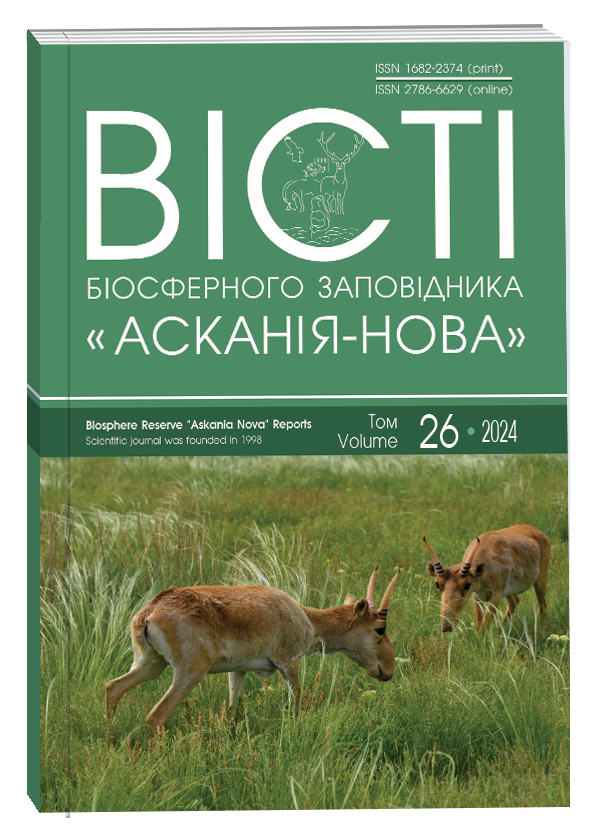VEGETATION SYNTAXONOMY OF THE CENTER FOR RESTORATION AND CONSERVATION OF ECOSYSTEMS "KASOVA HORA"
DOI:
https://doi.org/10.53904/1682-2374/2024-26/9Keywords:
Лучні степи, Опілля, ценотична різноманітність, синтаксономічна схема, Cirsio-Brachypodion pinnati, Geranion sanguinei, моніторингAbstract
This article is dealing with the syntaxonomy of vegetation of the Center for Restoration and Conservation of Ecosystems (CRCE) "Kasova Hora" (71 ha), created in 2023 on the part of the Kasova Hora tract that was not included in the Halytskyi National Nature Park. The purpose of the study is to assess the level of vegetation diversity and to establish a syntaxonomical scheme for the area of CRCE "Kasova Hora" as a basis for recommendations on differentiated management and forthcoming monitoring, and for evaluation of the effectiveness of protective efforts. The study was conducted in June 2023. It was found that the vegetation of the studied area is diverse and differentiated according to geomorphological and edapho-hydrological conditions, and land use practices in the past. Jointly, 10 associations and 1 community belong to the 8 alliances, 8 orders, and 7 vegetation classes are noticed here. Meadow-steppe vegetation is represented by the two associations of the alliance Cirsio-Brachypodion pinnati Hadač et Klika in Klika et Hadač 1944. On the gypsum outcrops, the community from the order Stipo pulcherrimae-Festucetalia pallentis Pop 1968 is observed. Thermophilous edges of the alliance Geranion sanguinei Tx. in T. Müller 1962 are represented by the three associations. Mesophitic hay meadows belong to the one association of the Arrhenatherion elatioris Luquet 1926 alliance. Shrub thickets of the Berberidion vulgaris Br.-Bl. ex Tx. 1952 alliance are attributed to the one association. Synanthropic vegetation of the Arction lappae Tx. 1937 and Senecionion fluviatilis Tx. ex Moor 1958 alliances are represented by the two associations. In wet depressions, the one association of the alliance Phragmition communis Koch 1926 is noticed. As a result of the cessation of the traditional management practices, a significant transformation of the vegetation cover is observed, which consists of overgrowth with shrubs and the spread of rhizomatous herbaceous species. In order to preserve and maintain the desired state of the meadow steppes vegetation of the CRCE "Kasova Hora", it is necessary to develop a differentiated regime of protective measures and efforts for different types of plant communities.
References
Дослідження рослинності Центру відтворення та збереження екосистем "Касова Гора" виконано за сприяння ГО "Еко-Галич" та фінансової підтримки фонду IFAW.
Абдулоєва О.С. До синтаксономії ксерофітної травʹянистої рослинності Західного Лісостепу (Придністровське Поділля, Товтровий кряж, Кременецькі гори). Український фітоценологічний збірник. Серія А. 2002. Вип. 1 (18). С. 124–144.
Абдулоєва О.С., Дідух Я.П. Лучно-степова рослинність еродованих схилів Придністровʹя (національний природний парк "Подільські Товтри") в аспекті її охорони. Український фітоценологічний збірник. Сер. А. 1999. Вип. 3 (14). С. 10–36.
Винокуров Д.С. Асоціація Inuletum ensifoliae Kozłowska 1925. В кн.: Дубина Д.В., Дзюба Т.П., Ємельянова С.М. та ін. Продромус рослинності України. Київ : Наукова думка, 2019. С. 253–254.
Дідух Я.П., Шеляг-Сосонко Ю.Р. Геоботанічне районування України та суміжних територій. Український ботанічний журнал. 2003. 60 (1). С. 6–17.
Дідух Я., Коротченко І. Ксеротермна рослинність Північно-Західного Поділля. Вісник Львівського університету. Серія біологічна. 2003. Вип. 34. С. 82–91.
Дмитраш-Вацеба І.І. Стан збереження популяцій раритетних видів рослин в умовах антропогенної трансформації лучних степів Південного Опілля. Вісник Дніпропетровського університету. Біологія, екологія. 2016. 24 (2). С. 353–358.
Заморока А.М., Шумська Н.В., Бучко В.В., Дмитраш-Вацеба І.І., Маланюк В.Б. Раритетна складова біоти лучних степів Бурштинського Опілля. В кн.: А. М. Заморока (ред.). Біота лучних степів Бурштинського Опілля. Івано-Франківськ : Симфонія форте, 2018. С. 140–173.
Заморока А.М., Шумська Н.В., Дмитраш-Вацеба І.І. Інвентаризація лучних степів Бурштинського Опілля. В кн.: А. М. Заморока (ред.). Біота лучних степів Бурштинського Опілля. Івано-Франківськ : Симфонія форте, 2018. С. 16–30.
Куковиця Г.С. Найбільша ділянка ковилого степу на Поділлі. Український ботанічний журнал. 1970. 27 (1). С. 111–113.
Куковиця Г.С., Дідух Я.П., Шеляг-Сосонко Ю.Р., Абдулоєва О.С. Синтаксономія лучних степів памʹяток природи республіканського значення гг. Касова та Чортова. Український фітоценотичний збірник, Серія А. 1998. 2 (11). С. 42–61.
Куковиця Г.С., Мовчан Я.І., Соломаха В.А., Шеляг-Сосонко Ю.Р. Синтаксономія лучних степів Західного Поділля. Український ботанічний журнал. 1994. 51 (2–3). С. 35–48.
Стеблій Н. Природне середовище в процесах заселення північно-західної України (І століття до н.е. – середина І століття н.е.). Вісник Інституту археології. 2006. 1. С. 16–26.
Стойко С.М., Мілкіна Л.І., Ященко П.Т., Кагало О.О., Тасєнкевич Л.О. Раритетні фітоценози західних регіонів України (Регіональна "Зелена книга"). Львів : Поллі. 1998. 190 с.
Токарюк А.І., Чорней І.І., Буджак В.В. Асоціація Brachypodio pinnati-Molinietum arundinaceae Klika 1939 в урочищі Підокруг (Буковинське Прикарпаття). Біологічні студії. 2018. 12 (1). С. 125–134. https://doi.org/10.30970/sbi.1201.553
Шеляг-Сосонко Ю.Р., Дідух Я.П., Єременко Л.П., Куковиця Г.С., Жижин М.П. Рослинність Касової гори (Опілля). Український ботанічний журнал. 1981. 36 (3). С. 60–66.
Шумська Н.В. Рослинність лучних степів Бурштинського Опілля. В кн.: А.М. Заморока (ред.). Біота лучних степів Бурштинського Опілля. Івано-Франківськ : Симфонія форте, 2018. С. 65–71.
Якушенко Д., Токарюк А., Чорней І. Високотравні узлісні угруповання класу Trifolio-Geranietea sanguinei T. Müller 1962 на Касовій горі. Мат-ли міжнар. наук.-практ. конф. "Збереження, відтворення та раціональне використання природних ресурсів обʹєктів ПЗФ" (Крилос-Галич, 9 серпня 2024 р). Галич. 2024. С. 213–217.
Bąba W. How Brachypodium pinnatum influence the species richness of the semi-natural xerothermic grasslands on calcareous rocks. In: L. Frey (ed.) Problems of grass biology. Kraków : W. Szafer Institute of Botany. Polish Academy of Sciences. 2003. 403–417.
Bobbink R., Willems J.H. Increasing dominance of Brachypodium pinnatum (L.) Beauv. in chalk grasslands: A threat to a species-rich ecosystem. Biological Conservation. 1987. 40 (4). 301–314. https://doi.org/10.1016/0006-3207(87)90122-4
Buckland S.M., Thompson K., Hodgson J.G., Grime J.P. Grassland invasions: Effects of manipulations of climate and management. Journal of Applied Ecology. 2001. 38. Р. 301–309. https://doi.org/10.1046/j.1365-2664.2001.00603.x
Budzhak V.V., Chorney I.I., Tokariuk A.I., Kuzemko A.A. Numeric syntaxonomical analysis of communities of the Molinia caerulea complex in Southwestern of Ukraine. Hacquetia. 2016. 15 (2). Р. 63–77. https://doi.org/10.1515/hacq-2016-0023
Chytrý M. Koelerio macranthae-Stipetum joannis Kolbek 1978. In: Chytrý M. (ed.). Vegetace České republiky. 1. Travinná a keříčková vegetace. Praha : Academia, 2007. Р. 418–420.
Chytrý M. Brachypodio pinnati-Molinietum arundinaceae Klika 1939. In: Chytrý M. (ed.). Vegetace České republiky. 1. Travinná a keříčková vegetace. Praha : Academia, 2007. Р. 447–449.
Didukh Ya., Vasheniak Iu., Bednarska I. Phytosociological and ecological peculiarities of Festuca pallens Host in Ukraine. Hacquetia. 2022. 21 (2). Р. 235–252. https://doi.org/10.2478/hacq-2022-0004
Didukh Ya., Vashenyak Iu., Chusova O. Stipo pulcherrimae-Festucetalia pallentis Pop 1968 of calcareous petrophytic steppes in Ukraine. Hacquetia. 2021. 20 (2). Р. 303–325. https://doi.org/10.2478/hacq-2021-0004
Didukh Ya.P., Vasheniak Yu.A. Vegetation of limestone outcrops in Western and Central Podillia (Ukraine). Tuexenia. 2018. 38. Р. 419–444. https://doi.org/10.14471/2018.38.023
Dmytrash-Vatseba I.I., Shumska N.V. Dynamics of plant cover of meadow steppes after the cessation of traditional management in Opillia. Biosystems Diversity. 2020. 28 (3). Р. 224–229. https://doi.org/10.15421/012029
Euro+Med 2006+ [continuously updated]: Euro+Med PlantBase – the information resource for Euro-Mediterranean plant diversity. Published at http://www.europlusmed.org [2/6/2024]
Hájková P., Hájek M., Kintrová K. How can we effectively restore species richness and natural composition of a Moliniainvaded fen? Journal of Applied Ecology. 2009. 46. Р. 417–425. https://doi.org/ 10.1111/j.1365-2664.2009.01608.x
Hájková P., Petr L., Horsák M., Jamrichová E., Roleček J. Holocene history of the landscape at the biogeographical and cultural crossroads between Central and Eastern Europe (Western Podillia, Ukraine). Quaternary Science Reviews. 2022. 228: 107610. https://doi.org/10.1016/j.quascirev.2022.107610
Hájková P., Roleček J., Hájek M., Horsák M., Fajmon K., Polák M., Jamrichová E. Prehistoric origin of the extremely species-rich semi-dry grasslands in the Bílé Karpaty Mts (Czech Republic and Slovakia). Preslia. 2011. 83. Р. 185–204.
Hennekens, S.M., Schaminée, J.H.J. Turboveg, a comprehensive database management system for vegetation data. Journal of Vegetation Science. 2001. 12. Р. 589–591. https://doi.org/10.2307/3237010
Klimeš L. Obnova opuštené louky pravidelnym kosením. In.: Louky Bílých Karpat (ed. I. Jongepierová). CSOP Bílé Karpaty, 2008. Р. 326–337.
Lysenko H.M., Danylyk I.M., Iemelianova S.M., Borsukevych L.M., Sosnovska S.V. Comparative assessment of Western Podolia meadow steppes (Ukraine) based on the synphytoindication method. Hacquetia 2021. 20 (1). Р. 197–216. https://doi.org/10.2478/hacq-2020-0018
Mucina, L., Bültmann, H., Dierssen, L., Theurillat, J.-P., Raus, T., Čarni, A., Šumberova, K., Willner, W., Dengler, J., Gavilán García, R., Chytrý, M., Hájek, M., Di Pietro, R., Iakushenko, D., Pallas, J., Daniëls, F., Bergmeier, E., Santos Guerra, A., Ermakov, N., Valachovič, M., Schaminée, J., Lysenko, T., Didukh, Ya., Pignatti, S., Rodwell, J., Capelo, J., Weber, H., Solomeshch, A., Dimopoulos, P., Aguiar, C., Hennekens, S., Tichý, L. Vegetation of Europe: hierarchical floristic classification system of vascular plant, bryophte, lichen, and algal communities. Applied Vegetation Science. 2016. 19, Supp. 1. Р. 3–264. https://doi.org/10.1111/avsc.12257
Nachychko V., Novikov A., Kuzyarin O. Proposal to conserve the name Thymus marschallianus (Lamiaceae) with a conserved type. Taxon. 2024. 73 (5). Р. 1304–1305. https://doi.org/10.1002/tax.13255
Onyshchenko V.A. (ed.). Important plant areas of Ukraine. Kyiv : Alterpress, 2017. 376 p.
Ridding L.E., Redhead J.W., Upcott E.V., Hulmes L., Hulmes S., Mitschunas N., Howell K., Christelow J., Wickenden A.R., Fussell M., Plunkett J., Pywell R.F. Practical methods for the control of tor-grass (Brachypodium pinnatum s.l.) and the restoration of calcareous grassland. Journal of Nature Conservation. 2024. 78. Р. 126566. https://doi.org/10.1016/j.jnc.2024.126566
Roleček J. A recent find of Ophrys insectifera (Orchidaceae) in Ukraine – will it survive another 100 years? Ukrainian Botanical Journal. 2021. 78 (4). Р. 297–302. https://doi.org/10.15407/ukrbotj78.04.297
Roleček J., Čornej I., Tokarjuk A. Understanding the extreme species richness of semi-dry grasslands in east-central Europe: a comparative approach. Preslia. 2014. 86. Р. 13–34.
Roleček J., Dřevojan P., Iakushenko D., Hájek M. Tall herb-rich steppe in the peri-Carpathian region of Ukraine and Romania. Phytocoenologia 2022. 51 (2). Р. 95–109. https://doi.org/10.1127/phyto/2021/0388
Roleček J., Hájek M., Dřevojan P., Prokešová H., Fajmon K., Těšitel J., Daněk P., Hájková P., Jongepierová I., Novák P., Poluyanov A.V., Shumska N.V., Chorney I.I. Gradients, species richness and biogeographical links of steppe grasslands in Western Podolia (Ukraine). Phytocoenologia 2019. 49 (4). Р. 349–367. https://doi.org/10.1127/phyto/2019/0255
Roleček J., Tichý L., Zelený D., Chytrý M. Modified TWINSPAN classification in which the hierarchy respects cluster heterogeneity. Journal of Vegetation Sciences. 2009. 20 (4). Р. 596–602. https://doi.org/10.1111/j.1654-1103.2009.01062.x
Westhoff V., van der Maarel E. The Braun-Blanquet approach. In: R. Whittaker (ed.). Classification of Plant Communities, 2-nd ed. The Hague : Junk, 1973. Р. 287–399.
Wierdak S. Skały i halawy w Międzyhorcach jako zabytek przyrody. Ochrona Przyrody. 1932. 12. 51-54.
Willner W., Roleček J., Korolyuk A., Dengler J., Chytrý M., Janišová M., Lengyel A., Aćić S., Becker T., Ćuk M., Demina O., Jandt U., Kącki Z., Kuzemko A., Kropf M., Lebedeva M., Semenishchenkov Y., Šilc U., Stančić Z., Staudinger M., Vassilev K., Yamalov S. Formalized classification of semi-dry grasslands in central and eastern Europe. Preslia. 2019. 91. Р. 25–49. https://doi.org/10.23855/preslia.2019.025







